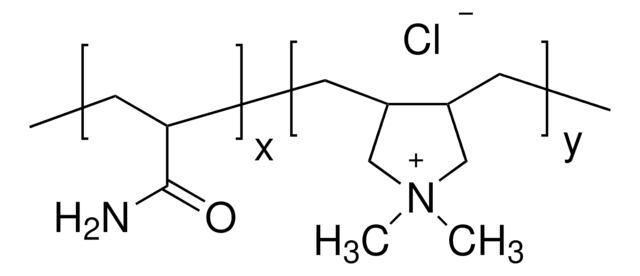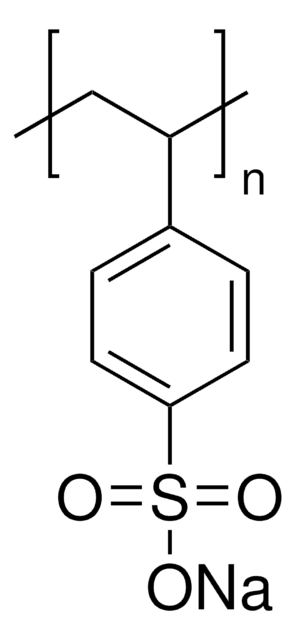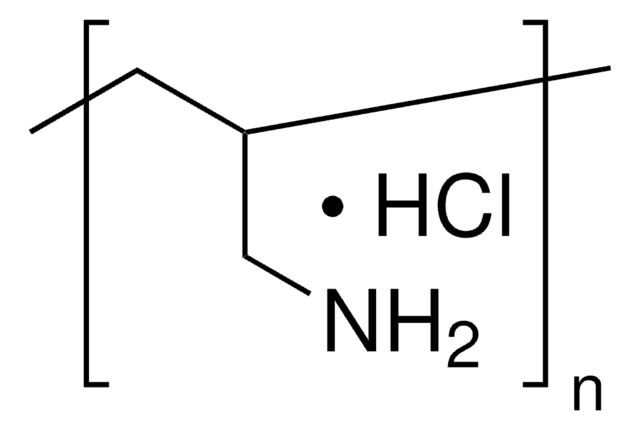추천 제품
분자량
average Mw <100,000 (very low molecular weight)
농도
35 wt. % in H2O
refractive index
n20/D 1.417
점도
100-200 cP(25 °C)
density
1.09 g/mL at 25 °C
InChI
1S/C8H16N.ClH/c1-5-7-9(3,4)8-6-2;/h5-6H,1-2,7-8H2,3-4H3;1H/q+1;/p-1
InChI key
GQOKIYDTHHZSCJ-UHFFFAOYSA-M
유사한 제품을 찾으십니까? 방문 제품 비교 안내
일반 설명
Poly(diallyldimethylammonium chloride) (PDDA) is a cationicpolyelectrolyte that easily ionizes when dissolved in water. This polymer iswidely used in the fields of waste-water treatment (as a flocculant) and the functionalizationof nanoparticles.
애플리케이션
Poly(diallyldimethylammonium chloride) can be used as a stabilizing agent in the synthesis of nanoparticles such as capped copper hexacyanoferrate (CuHCF) nanoparticles. The addition of PDDA protects the particles from aggregation and allows the synthesis of nanoparticles with controlled size and polydispersity. It can also be used to fabricate chemical and biological sensors. For example, PDDA-modified catalyst platforms can be used in the electrochemical detection of L-cysteine.
Storage Class Code
10 - Combustible liquids
WGK
WGK 1
Flash Point (°F)
>212.0 °F - closed cup
Flash Point (°C)
> 100 °C - closed cup
개인 보호 장비
Eyeshields, Gloves, multi-purpose combination respirator cartridge (US)
이미 열람한 고객
The p-type MoS2 nanocube modified poly(diallyl dimethyl ammonium chloride)-mesoporous carbon composites as a catalytic amplification platform for electrochemical detection of l-cysteine
Zhixiang Zheng, et al.
Sensors and Actuators B, Chemical, 221, 1162-1169 (2015)
Shangzhi Chen et al.
Nature nanotechnology, 15(1), 35-40 (2019-12-11)
Being able to dynamically shape light at the nanoscale is one of the ultimate goals in nano-optics1. Resonant light-matter interaction can be achieved using conventional plasmonics based on metal nanostructures, but their tunability is highly limited due to a fixed
Lokesh S Koodlur
Bioelectrochemistry (Amsterdam, Netherlands), 91, 21-27 (2013-01-22)
A self-assembled molecular film of a water-soluble cobalt tetrasulfophthalocyanine was deposited on a gold substrate premodified with poly(diallyldimethylammonium chloride). The process of layer-by-layer assembly on the gold substrate was characterized using UV-Vis, Raman spectroscopy, ellipsometry, contact angle measurements, atomic force
Lulu Han et al.
Biomaterials, 34(4), 975-984 (2012-11-07)
The directional cell migration plays a crucial role in a variety of physiological and pathological processes. It can be controlled by the gradient cues immobilized on the substrate. The poly(sodium 4-styrenesulfonate) (PSS)/poly(diallyldimethylammonium) chloride (PDADMAC) multilayers were post-treated in a gradient
M M Ottakam Thotiyl et al.
Journal of colloid and interface science, 383(1), 130-139 (2012-07-20)
Multilayers of poly(diallyldimethylammonium chloride) (PDDA) and citrate capped Au nanoparticles (AuNPs) anchored on sodium 3-mercapto-1-propanesulfonate modified gold electrode by electrostatic layer-by-layer assembly (LbL) technique are shown to be an excellent architecture for the direct electrochemical oxidation of As(III) species. The
문서
Layer-by-Layer (LbL) Assembly, A "Gentle Yet Flexible" Method Toward Functional Biomaterials
We present an article that discusses two applications in particular; first, using these layers as polyelectrolyte membranes to control permeability.
자사의 과학자팀은 생명 과학, 재료 과학, 화학 합성, 크로마토그래피, 분석 및 기타 많은 영역을 포함한 모든 과학 분야에 경험이 있습니다..
고객지원팀으로 연락바랍니다.






![Poly[(2-ethyldimethylammonioethyl methacrylate ethyl sulfate)-co-(1-vinylpyrrolidone)] average Mw <1,000,000 by GPC, 20 wt. % in H2O](/deepweb/assets/sigmaaldrich/product/structures/334/533/03fcaede-76a6-4b5a-a992-9565ea1ace4a/640/03fcaede-76a6-4b5a-a992-9565ea1ace4a.png)